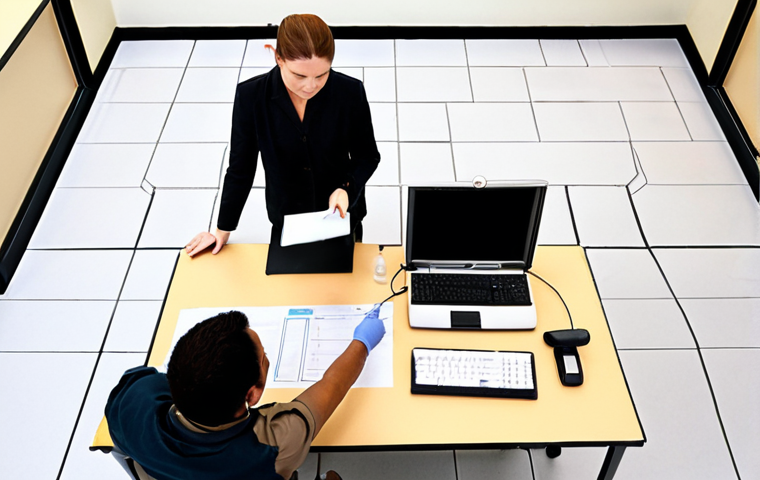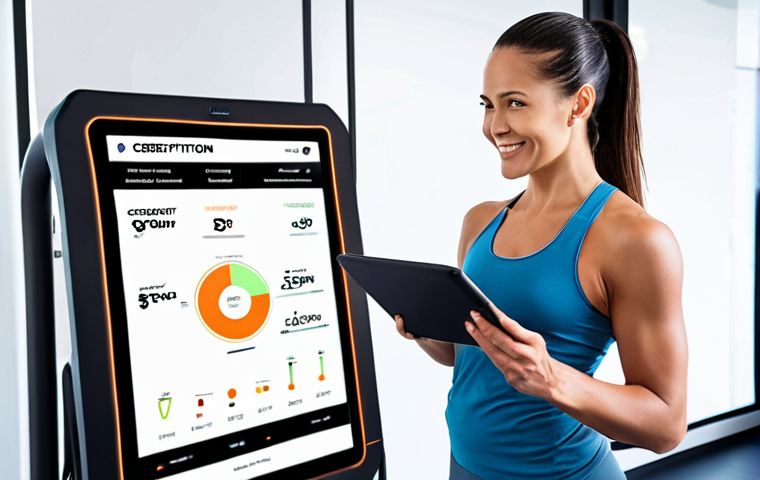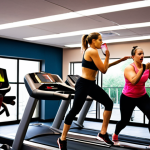I remember the nervous excitement of preparing for my own fitness management certification exam – the countless hours studying, the adrenaline building up.
But amidst all that preparation, one thing consistently brings peace of mind: knowing exactly where you need to be on test day. It’s not just about logistics; it’s about minimizing those last-minute stresses so you can truly focus on what matters.
As someone who’s navigated this path, I can tell you that this certification is your essential passport into a rapidly evolving industry, where personalized wellness, digital integration, and even AI-driven coaching are reshaping client expectations.
The demand for skilled, certified professionals who can expertly manage these innovative trends is only growing, making your certification more valuable than ever in securing a robust career future.
Don’t let uncertainty about your exam venue add to your pre-test anxiety. Let’s dive deeper into the details below.
I remember the nervous excitement of preparing for my own fitness management certification exam – the countless hours studying, the adrenaline building up.
But amidst all that preparation, one thing consistently brings peace of mind: knowing exactly where you need to be on test day. It’s not just about logistics; it’s about minimizing those last-minute stresses so you can truly focus on what matters.
As someone who’s navigated this path, I can tell you that this certification is your essential passport into a rapidly evolving industry, where personalized wellness, digital integration, and even AI-driven coaching are reshaping client expectations.
The demand for skilled, certified professionals who can expertly manage these innovative trends is only growing, making your certification more valuable than ever in securing a robust career future.
Don’t let uncertainty about your exam venue add to your pre-test anxiety. Let’s dive deeper into the details below.
Demystifying Your Exam Day Venue: Location, Logistics, and More

When I was prepping for my certification, I vividly remember the gut-wrenching feeling of not knowing exactly where I was supposed to go. It’s like arriving at a massive concert venue without a map, just hoping you stumble into the right stage.
That kind of uncertainty can chew away at your focus, and on exam day, focus is your most valuable asset. My own experience taught me that verifying the exact address, understanding parking options, and even scouting out the area days before can save you a mountain of stress.
I can’t stress enough how crucial it is to confirm the test center’s hours of operation, especially for early morning exams. What if they open late, or you get there too early and are just left waiting in the cold?
Trust me, I’ve seen it happen. It’s not just about showing up; it’s about arriving prepared, rested, and with minimal external distractions. You’re investing so much in this exam, don’t let a preventable logistical hiccup undermine your hard work.
Think of it as the first hurdle in the race – clear it smoothly, and the rest of the course feels a little less daunting.
1. Pinpointing Your Testing Center
Knowing the exact address is just the first step. You need to consider how you’ll get there. Will you drive, take public transport, or perhaps even arrange a ride-share?
I always prefer to drive if possible, primarily for the control it gives me over my arrival time and the ability to carry my specific comfort items. However, if driving isn’t an option, familiarize yourself with bus routes or train schedules and build in significant buffer time.
Traffic is unpredictable, especially in urban areas, and you don’t want to be stuck in gridlock, watching the clock tick down, your heart pounding with every minute.
It’s a terrible feeling, and one I actively tried to avoid. I’ve heard horror stories of people missing their exam slot by mere minutes because of an unexpected detour or a sudden road closure.
2. Understanding Parking and Accessibility
Parking can be a nightmare if not planned ahead. When I took my exam, I actually drove to the venue a week beforehand, just to scope out the parking situation.
Were there garages, street parking, or designated lots? What were the rates? Some test centers are in commercial buildings with expensive hourly parking, which can add an unexpected cost and a layer of annoyance.
If you have any accessibility needs, verifying ramp access, elevator availability, or specific seating arrangements is absolutely non-negotiable. Don’t assume – always confirm.
A comfortable and accessible environment is paramount for optimal performance. It’s about setting yourself up for success, not battling preventable issues.
Crafting Your Pre-Exam Strategy: A Mindset Masterclass
The days leading up to the exam are critical, not just for last-minute cramming, but for cultivating a winning mindset. I recall feeling a rollercoaster of emotions – excitement, dread, intense focus, and sometimes, overwhelming doubt.
It’s natural. But what truly makes a difference is how you manage those emotions. I discovered that a calm, prepared mind is far more effective than an over-stressed, over-caffeinated one.
This isn’t just about reviewing flashcards; it’s about mentally rehearsing the day, visualizing success, and building a reservoir of confidence. Remember, you’ve put in the hours, you’ve absorbed the material, now it’s time to trust your preparation.
My personal secret was to treat the exam as a performance – not just a test of knowledge, but a test of endurance and composure.
1. The Power of a Dress Rehearsal
I’m a big believer in the dress rehearsal. A few days before my exam, I actually packed my bag, laid out my clothes, and even drove the route to the test center at the exact time I would be leaving on exam day.
This isn’t overkill; it’s a strategic move to eliminate any last-minute surprises. What if you realize your preferred transit route is unexpectedly closed?
Or that parking garage only opens at 8 AM and your exam starts at 8:30 AM? These are the little details that can throw a huge wrench into your carefully planned day.
By doing a dry run, you identify potential pitfalls and iron them out beforehand, leaving you with one less thing to worry about when it truly matters.
It’s like a warm-up before a big workout – you test the movements, get your body ready, and ensure everything feels right.
2. Cultivating Calm: Pre-Exam Rituals
For me, a pre-exam ritual involved a specific playlist, a light but nourishing breakfast, and a quiet moment of meditation. I’ve found that listening to calming instrumental music helped regulate my breathing and quieted the internal chatter.
A high-sugar breakfast might give you a quick burst of energy, but it often leads to a crash, which is the last thing you want mid-exam. Instead, I opted for protein and complex carbs – eggs, whole-grain toast, some fruit.
This sustained my energy levels without the jitters. And that short meditation? It wasn’t about emptying my mind, but about acknowledging my nervousness and then gently redirecting my focus towards my capabilities.
It’s about reminding yourself, “I’ve got this. I’ve prepared for this.”
Essential Gear: What to Pack for Peak Performance
Just as a fitness professional wouldn’t show up to a client session without their essential tools, you shouldn’t show up to your exam without yours. But beyond the obvious, there are often specific items that can make or break your comfort and focus.
I remember fretting over what kind of calculator was allowed (yes, some are specific!) and worrying about snacks. Over-packing can be as bad as under-packing; you want a lean, efficient kit that supports your performance without adding clutter or distractions.
My philosophy is to pack smart, not just pack everything. Think of it as packing for a mini-expedition: every item should serve a clear purpose in getting you through the journey successfully.
1. The Non-Negotiables: Your Core Exam Kit
These are the absolute must-haves. Double-check your admission ticket, a valid form of government-issued photo identification (like a driver’s license or passport), and any specific materials required by the testing body.
For my fitness certification, I needed a specific type of calculator – not just any old one from my desk drawer. Confirm these details well in advance, often found in your exam registration confirmation.
2. Comfort and Sustenance: Optimizing Your Environment
Even if you’re not allowed food or drink *in* the testing room, having water and a small, easily digestible snack for breaks is a game-changer. Dehydration and low blood sugar can severely impact cognitive function.
I always bring a light jacket or a long-sleeved shirt, even if it’s warm outside, because testing centers can be notoriously cold or have wildly fluctuating temperatures.
A slight chill can be incredibly distracting. Consider also:
* A clear water bottle (often required for visibility). * A light, healthy snack like an apple or a granola bar.
* Layers of clothing to adapt to room temperature. * Earplugs (if allowed and if you’re sensitive to ambient noise). * Any prescribed medications you might need.
Navigating the Unknown: My Personal Test Day Reflections
I vividly recall the mix of anxiety and quiet determination on my actual exam day. The air in the testing center felt thick with unspoken ambition. Everyone was there for the same reason, but each person was on their own unique journey.
Walking into that room, seeing the rows of computers, the silence broken only by the click of keys and the occasional rustle – it was surreal. My own experience taught me that adaptability is key.
Despite all my meticulous planning, there were still unexpected moments: a slightly uncomfortable chair, the hum of the air conditioning, or a small delay in starting.
These are moments where your mental resilience is truly tested. It’s not about being perfect, but about being able to adjust and keep your focus unwavering amidst minor distractions.
I remember taking a deep breath before hitting “start,” a small ritual to ground myself.
1. Checking In: More Than Just ID
The check-in process itself can be a mini-stressor if you’re unprepared. You’ll typically need your ID and admission ticket. Some centers take fingerprints, or even a digital photo.
Be patient and polite. The staff are there to ensure the integrity of the exam, not to make your life difficult. I found that having all my documents ready and easily accessible made the process smooth and kept my pre-exam jitters at bay.
2. During the Exam: Pacing and Perseverance
Once you’re seated and the timer begins, it’s all about your strategy. My advice? Don’t dwell too long on any single question.
If you’re stuck, flag it and move on. You can always come back to it if time allows. I also made sure to take the allowed breaks, even if I felt I didn’t need them.
Stepping away for a few minutes, stretching, grabbing a sip of water – it allowed me to clear my head and return with renewed focus. That short mental reset can be incredibly powerful in maintaining endurance over a long exam.
It’s a marathon, not a sprint, and pacing yourself is vital.
| Pre-Exam Day Checklist | Notes & Tips |
|---|---|
| Confirm Venue Address & Directions | Double-check on mapping apps; consider a dry run. |
| Research Parking Options | Cost, availability, and accessibility. |
| Prepare Required Identification | Valid government-issued photo ID (driver’s license, passport). |
| Print Admission Ticket/Confirmation | Keep multiple copies, digital and physical. |
| Pack Your Exam Kit | Allowed calculator, water, snacks, layers of clothing. |
| Plan Your Outfit | Comfortable, breathable, and layered clothing. |
| Set Multiple Alarms | Ensure you wake up with plenty of time. |
| Review Exam Day Rules | No electronics, specific break rules, etc. |
| Get a Good Night’s Sleep | Crucial for cognitive function. |
The Crucial Role of Comfort: Making Your Test Environment Work for You

I always say that your physical comfort directly impacts your mental performance. Imagine trying to solve complex problems while fidgeting in an uncomfortable chair or shivering from a blasting air conditioner.
It’s nearly impossible to sustain deep focus. My own experience taught me to prioritize comfort elements that are within my control. While you can’t re-arrange the testing center furniture, you can come prepared.
I always brought a light sweater or jacket, even in summer, because test centers have a notorious reputation for being cold. I’ve heard stories of people being so distracted by the temperature that they couldn’t concentrate on the questions, which is a truly tragic waste of all that studying.
1. Dressing for Success (and Comfort)
This isn’t a fashion show; it’s about practical comfort. Wear loose, breathable clothing. Think layers!
A t-shirt under a hoodie or a sweater allows you to adjust to the room’s temperature. I’ve been in testing rooms that felt like a sauna and others that were colder than a walk-in fridge, sometimes in the same building.
Your clothing choices can be a minor superpower against these unpredictable environments. Also, make sure your shoes are comfortable – you might be sitting for hours, but a quick stretch or walk during a break will feel much better in comfortable footwear.
2. Minimizing Sensory Overload
Testing centers can be surprisingly noisy – the rhythmic tapping of keyboards, someone else clearing their throat, or even the distant sounds of traffic.
While you can’t control everything, if allowed, bringing earplugs can be a godsend. I once had a test where the person next to me was audibly chewing gum throughout.
It was maddening! A good pair of noise-canceling earplugs (check if allowed first!) can create a personal bubble of quiet, allowing you to tune out distractions and focus purely on the exam content.
Even a simple pair of foam earplugs can make a world of difference in maintaining your concentration.
Anticipating the Unforeseen: Contingency Planning for Peace of Mind
No matter how meticulously you plan, life sometimes throws curveballs. I distinctly remember a mild panic attack when I almost forgot my ID on exam day – a moment of pure dread.
Or the time my car almost ran out of gas on the way. These moments highlight the importance of having a Plan B, or even a Plan C. It’s not about dwelling on what could go wrong, but proactively preparing for it, so you can calmly navigate any unexpected bumps in the road.
For me, that meant having my ID in a specific, easily accessible pocket, and ensuring my car had plenty of fuel the night before. This foresight transforms potential disasters into mere inconveniences.
1. Backup Plans for Transport and Identification
What if your car breaks down? What if your train is delayed? Having a backup plan for transportation is essential.
Maybe it’s the number for a trusted ride-share, or knowing a second public transport route. And your ID? Keep it separate from your wallet if you tend to misplace it.
I’ve known people who have had to scramble to get a temporary ID on exam day because they lost their primary one, which is an agonizing way to start something so important.
Always confirm what forms of ID are accepted and have at least two readily available.
2. Handling Unexpected Delays or Technical Glitches
Test centers, while professional, aren’t immune to technical issues. Computers freeze, networks go down, or there might be an unexpected delay in starting the exam.
My best advice here is to practice patience and communicate clearly with the proctors. Freaking out won’t solve the problem; a calm, assertive approach will.
I once had a computer glitch during my exam, and the proctor was very helpful. I took a deep breath, explained the situation, and it was resolved quickly.
Remember, these things happen, and the staff are usually equipped to handle them. Your job is to stay composed and trust the process.
Beyond the Score: Leveraging Your Certification for Career Growth
As someone who’s walked this path, I can tell you that passing the exam is just the beginning. The real value of your fitness management certification isn’t just the piece of paper; it’s the doors it opens and the confidence it instills.
I remember the incredible sense of accomplishment, yes, but also the realization that this was my official launchpad. In today’s dynamic fitness industry, employers are actively seeking certified professionals who can demonstrate not just knowledge, but also the initiative and foresight to handle real-world challenges, including those related to technology, client management, and even business development.
This certification tells potential clients and employers that you’re serious, you’re credible, and you’ve invested in your expertise. It’s a powerful differentiator in a crowded market.
1. From Test Day to Client Success
The skills you gained while preparing for this exam—discipline, problem-solving, attention to detail—are incredibly transferable to managing client relationships and even your own fitness business.
I’ve found that the structured thinking required to ace the test translates directly into creating effective, personalized fitness plans and managing client expectations.
This certification isn’t just theory; it’s a framework for practical application. It helps you build trust with clients, assuring them that you possess a foundational understanding of the science and business of fitness.
It empowers you to speak with authority and provides a solid basis for continuous learning and adaptation in your career.
2. Building Your Professional Brand
Your certification is a cornerstone of your professional brand. Don’t underestimate its power. It’s not just a credential; it’s a statement about your commitment to excellence and your dedication to the well-being of others.
I immediately updated my LinkedIn profile and professional website after getting my results. This isn’t just about showing off; it’s about signaling to the market that you are a qualified expert.
Attending industry events, networking with other certified professionals, and actively seeking out mentorship opportunities are all crucial steps to maximize the value of your new credential.
This is where the initial investment of time and effort truly begins to pay dividends, allowing you to grow your client base, command higher rates, and explore new avenues within the fitness industry.
Concluding Thoughts
As you stand on the cusp of your fitness management certification exam, remember that every hour of study, every practice question, and every moment of preparation has brought you to this point. It’s more than just a test; it’s a rite of passage into a fulfilling and dynamic career. My own journey, filled with its share of nervous moments and triumphs, taught me that meticulous planning is not just about avoiding stress, but about building an unshakeable foundation of confidence. You’ve invested in yourself, in your knowledge, and in your future clients. Now, armed with the strategies we’ve discussed and your well-earned expertise, you are ready to shine. Trust your preparation, believe in your capabilities, and walk into that testing center knowing you’ve got this.
Useful Information
1. Always cross-reference your exam details with the official website of your certifying body (e.g., NASM, ACE, ACSM) as policies can change without notice, especially regarding allowed items or identification requirements.
2. Most major testing centers like Pearson VUE or Prometric have specific security protocols, including pat-downs or metal detectors, so arrive with ample time and minimize personal belongings to avoid delays.
3. If you require special accommodations due to a disability, contact your certifying body well in advance of your exam date to arrange for necessary adjustments and ensure a comfortable testing environment.
4. Be aware of local public transport schedules and potential traffic patterns, especially if your exam is during peak commuting hours in a major city like New York or London; factor in significant buffer time.
5. After your exam, resist the urge to immediately check online forums for answers. Give yourself a mental break, and then focus on the next steps for leveraging your new certification, such as updating your professional profiles or networking.
Key Takeaways
Thorough preparation for your fitness management certification exam extends beyond studying; it involves mastering logistics, cultivating a strong mindset, and meticulous planning for test day. Confirm your venue, understand parking and accessibility, and conduct a “dress rehearsal” to eliminate surprises. Pack an essential kit for comfort and focus, including layers of clothing and allowed snacks. Develop a robust pre-exam strategy that prioritizes mental calm and physical well-being. Anticipate potential challenges with contingency plans for transport and technical glitches. Finally, view this certification as your launchpad, a powerful tool to build your professional brand and propel your career in the ever-evolving fitness industry.
Frequently Asked Questions (FAQ) 📖
Q: Why is this fitness management certification such a game-changer for a career in today’s evolving wellness industry?
A: Oh, man, where do I even begin? When I first got into this, the fitness world felt a bit more straightforward, but now? It’s like a whole new universe opening up.
This certification isn’t just a piece of paper; it’s your essential passport into an industry that’s morphing at warp speed. Think about it: personalized wellness isn’t just a buzzword anymore, it’s what clients demand.
Digital integration means we’re connecting with people in ways we never imagined, and even AI-driven coaching is becoming a real-life game-changer. Believe me, I’ve personally seen how clients are expecting more sophisticated, data-driven, and genuinely customized experiences.
This certification isn’t just about ticking a box; it’s about proving you’ve got the chops, the expertise, and the foresight to expertly navigate and even lead these innovative trends.
That’s why the demand for truly skilled, certified professionals is absolutely skyrocketing, making your certification incredibly valuable for securing a robust, future-proof career.
It truly sets you apart.
Q: How does having the exact exam venue details beforehand significantly help in minimizing pre-test anxiety?
A: I totally get that feeling, the one where your stomach’s doing flip-flops before a big exam. I remember it vividly from my own certification test – all that nervous excitement!
And honestly, one of the biggest stress-relievers, something that consistently brought me a weird sense of calm, was knowing exactly where I needed to be.
It’s not just about the address; it’s about stripping away those niggling, last-minute worries. You don’t have to fret about traffic, finding parking, or even figuring out which building entrance is the right one.
That peace of mind, that mental space you free up by having those logistics locked down, is HUGE. It means you can funnel all that pre-test adrenaline into your actual performance, truly focusing on recalling all that hard-earned knowledge, instead of stressing about finding the right door.
Trust me, it makes a world of difference.
Q: Beyond securing a career, what are some personal benefits you’ve experienced or observed from holding a fitness management certification?
A: Okay, so beyond the obvious career boost – which is undeniable, by the way – there are some seriously impactful personal benefits that really hit home.
For me, it was this incredible surge of confidence. Knowing I’d put in the hours, mastered the material, and earned that certification gave me this undeniable authority when talking to clients and colleagues.
It wasn’t just theoretical knowledge; it was a tangible validation of my expertise. I’ve seen this ripple effect in others too: a greater sense of purpose, a deeper commitment to ethical practice, and even improved critical thinking skills because you’re constantly evaluating new information against a solid knowledge base.
It empowers you not just to manage fitness, but to truly lead and innovate, making a real, positive impact on people’s lives. It’s more than a credential; it’s a catalyst for personal and professional growth.
📚 References
Wikipedia Encyclopedia
구글 검색 결과
구글 검색 결과
구글 검색 결과
구글 검색 결과
구글 검색 결과




